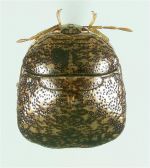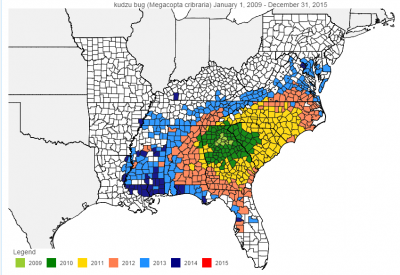As the days shorten and autumn approaches, it’s the time to start thinking about the insects that select our homes and businesses as their overwintering vacation spots. The first one I’ll mention is the kudzu bug, Megacopta cribraria, a small, somewhat hemispherical relative of the stinkbug. It is also called the bean plataspid, globular stink bug or lablab bug. It is native to India and 
The pest, introduced into the Atlanta, Georgia area in 2009, is now found in 95 North Carolina counties and throughout much of the southeastern US.
The kudzu bug is primarily a pest of legumes such as beans, soybeans, wisteria, and kudzu. When feeding on plants other than kudzu there is a reduction in crop yield. When feeding on kudzu, however, there is a noticeable decrease in the growth of the plant.
As cool weather approaches, the bugs move out of their summer feeding sites and begin to congregate on other plants such as figs, pole beans, redbuds, roses, peppers, and other plants searching for places to overwinter. At this time they will also invade homes. Beekeepers have even reported them massing near the entrance to beehives.
Ken Ahlstrom, Ph.D., Economy Exterminators, Inc., Apex, NC 27523





